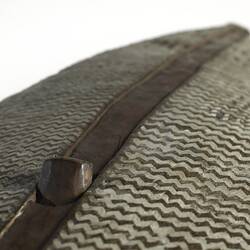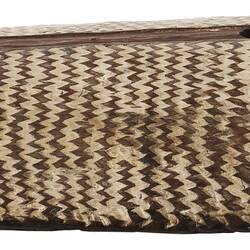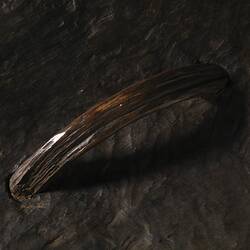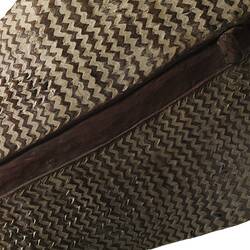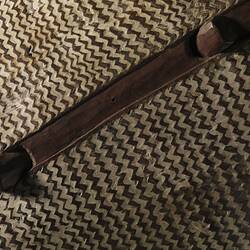Summary
Broad shields were used to deflect spears in close combat. The designs on the shields were meant to be visually arresting with dexterous combatants able to use them to create distracting optical illusions in battle. Shields could also be regarded as having innate power and older shields used in many successful battles were prized objects of trade.
The designs on shields of south-eastern Australia are infinitely variable, and no two are exactly the same. Like other art forms in the south-east the meaning of the designs relate to individual and group identity.
Local Name
Geyami
Physical Description
A broad shield with tapering ends made from hardwood painted with natural pigments. The concave outer surface has two sections of incised patterning separated by a single column of red ochre. It is decorated with a zig-zag pattern of horizontal and parallel lines painted with white pipe clay. The handle is made of a bent stick inserted into two holes were drilled through the shield and secured to the reverse side.
Significance
The ornamentation of this shield has been undertaken with great skill and care. The tool used to engrave the elaborate wavy design is made from the lower jaw of a possum. The surface and broad strip down the middle have been coloured with ochre, the incised grooves have been filled with white pipeclay.
Viewing this beautiful historic shield, Wadi Wadi craftsman Brendan Kennedy explains:
'The designs and incisions need to be done when the wood is raw or fresh; the wood hardens over time and is much more difficult to work. Different species of tree need to be incised with different tools- for some you can use a stone tool or bone engraver, others can be worked with a mussel shell. The easiest colours to find in this Riverina area are red and white, which both come from the banks of the Murray River. Yellow is the most difficult to find, and only sometimes is it found with the red. I grind charcoal to mix with the various colours when I want to create darker shades or greys'.
Brendan Kennedy 2013.
More Information
-
Object/Medium
Shield
-
Maker
-
Locality
-
Date Produced
-
Date Collected
-
Object Measurements
880 mm (Length), 250 mm (Width), 15 mm (Height)
-
Classification
-
Date Made
-
Maker
-
Clan/Language Group
-
Place Made
-
Indigenous Region
-
Keywords
-
References
[Catalogue] Rowlison, Eric, et al. 1981. Aboriginal Australia.
[Book] Museum Victoria. 2004. Treasures of the Museum. Victoria, Australia. 206.
-
Type of item
-
Discipline
-
Category
-
Collecting Areas



